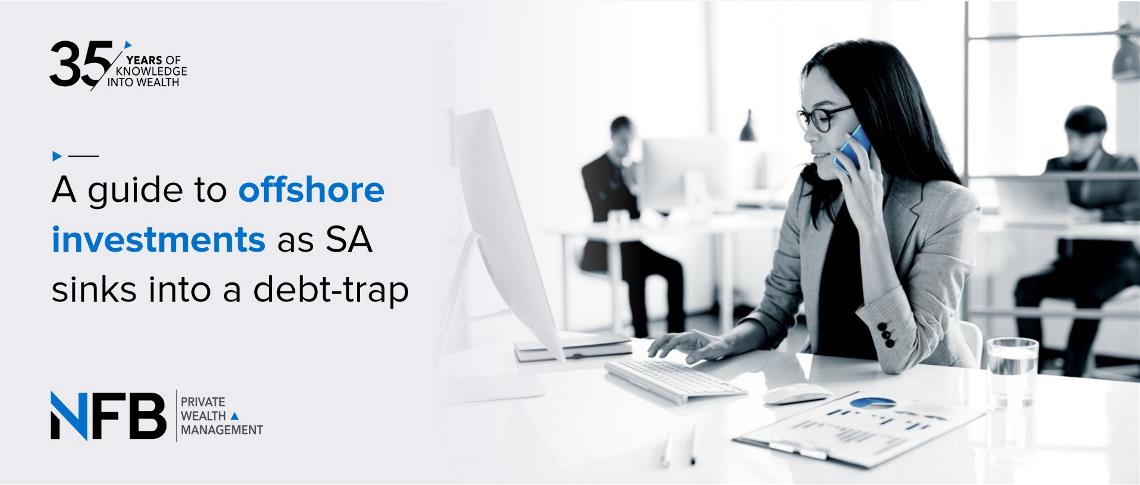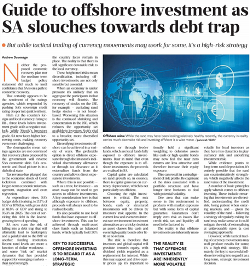A guide to offshore investments as SA sinks into a debt-trap
While tactical trading of currency movements may work for some, it’s a high-risk strategy


Neither President Ramaphosa’s proposed economic recovery plan, nor the Medium Term Budget Policy Statement announced in October, did much to instill confidence that the country is on a path to economic recovery. Last Friday two ratings agencies responded by pushing South Africa’s sovereign credit rating deeper into junk status.
Fitch cut the country’s foreign and local currency rating to BB-, which is three levels below investment grade, with a negative outlook, while Moody’s investors Services cut their rating to Ba2, which is two levels below investment grade. As a result of these downgrades South Africa now faces higher borrowing costs making any hope of an economic recovery even more challenging.
These downgrades point to ratings agencies being unconvinced that the recovery plans being proposed by government will reverse South Africa’s economic slide. It’s hard to argue against the view that the South African economic and fiscal picture is in a diabolical state. Tax revenue has plunged off the back of the economic shock of COVID lockdowns combined with longer term economic mismanagement, stagnation and even regression. As expenditure rises, South Africa’s budget deficit is rising to 15.7% or R76.1 billion with gross debt at 81.8% of GDP and rising to 95.3% in 2025. The cost of servicing this debt is the fastest growing item of spending.
South Africa runs the very real risk of falling into a debt trap that will ultimately lead to bankruptcy and a painful visit to the IMF – or another funding institution. Given these latest downgrades, the cost of borrowing for the South African government will increase, exacerbating issues as our debt load increases.
Recent ZAR levels are more a function of dollar weakness and some ‘risk on’ market dynamics that has provided support for emerging markets, than as a result of ZAR strength. While this has provided some welcome respite, the fundamental and structural issues that the country faces remain in place and the reality is that there is still significant downside risk to the ZAR.
These heightened risks mean that diversification, including offshore investments, are not only sensible, but essential. When an economy is under pressure, it is unlikely that on aggregate the participants in that economy will flourish. The recovery of stocks on the Johannesburg Stock Exchange, for example – excluding ZAR hedge stocks – is not broad-based. Exacerbating this situation is the continued shrinking and concentration within the JSE which makes the opportunity set available to investors smaller. From a diversification perspective it is therefore vital to have exposure to foreign markets given that they offer investors access to a broader and more diversified opportunity set.
Diversifying investments offshore can be achieved in a variety of ways. The preferable option is direct offshore exposure through the investor’s individual’s discretionary allowance or through tax clearance as it externalises funds from the country and allows direct exposure to investments.
Where this is not possible – such as a trust, for example – an asset swap can be used to get access to offshore investments. However, a key consideration here is that although exposure is offshore, proceeds will always need to be realised in South Africa.
It’s also possible to use local funds that have exposure to offshore investments. This can be achieved through multi asset class funds such as ‘balanced funds’ which typically hold 30% offshore, or through ‘feeder funds’ which are local funds that are fully exposed to offshore investments. Once again, bear in mind that even though the exposure is to offshore investments, the proceeds are realised in South Africa. What also needs to be factored in is that capital gains are calculated on ZAR growth so, in essence, there is capital gains tax on currency depreciation which is not particularly tax efficient.
Choosing the right investment for your particular risk profile is critical. The mix between equity, property, bonds, cash or structured investments will be driven by risk appetite and the investor’s ability to deal with volatility. In the current low and even zero interest rate environment, investment alternatives are a tricky decision as asset classes like cash and even high quality bonds offer little or no return.
The risk therefore is that investors and global capital will gravitate towards equity, with dividend yields regarded as a replacement for interest. While this may well support and drive equity prices up, it’s important to understand the risks investors are exposed to. Whereas in the past, investors may have held a significant weighting to defensive assets like cash or high-quality bonds, they may now feel that the near zero returns are less attractive and therefore upweight their equity exposure. This can result in a misalignment of risk profile. It’s key that investors are cognisant of the risks associated with their portfolio structure and have longer time horizons to deal with potential volatility.
One area that can make sense in this environment is in products with market exposure but some form of capital guarantee. It’s important to understand that guarantees don’t imply zero risk as issues like credit risk, tax and liquidity all need to be factored in. However, while these kinds of strategies can play an important role in a diversified portfolio they should not be seen as a panacea to investing in this environment.
The reality is that offshore investments are inherently more volatile for South African investors as they have two dynamics in play: currency risk and underlying investment risk. While all evidence currently points to long-term ZAR depreciation, it is entirely possible that the ZAR can at times – sometimes counterintuitively – strengthen, which negatively impacts the ZAR value of the investment. This volatility is particularly challenging for cautious investors, or those who are drawing from their portfolios.
A number of basic principles apply when it comes to offshore investing. These include ensuring that investments are diversified, understanding the credit risk, being patient when entering markets, and – given the volatility of the ZAR – following a strategy of regularly exiting the ZAR may make sense as it could mitigate against the risk of externalising at unfavourable rates (a cost averaging approach). However, while tactical trading of currency movements may well produce results for some, it is a high risk strategy. Ultimately, the key to successful offshore investing is to regard it as a long-term, strategic investment decision.
 This article was originally printed in Business Day and subsequently published by various online media outlets including Business Live, Moneyweb and SA Finance news
This article was originally printed in Business Day and subsequently published by various online media outlets including Business Live, Moneyweb and SA Finance news












